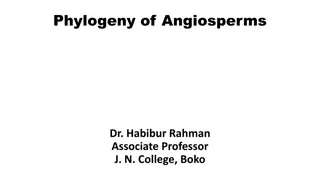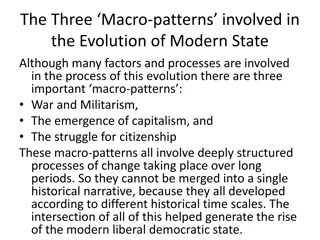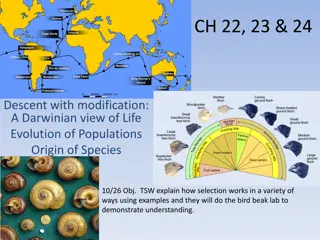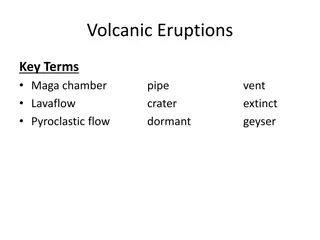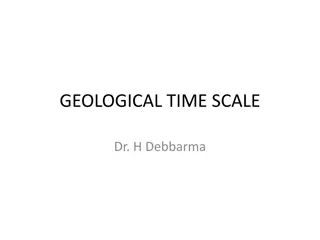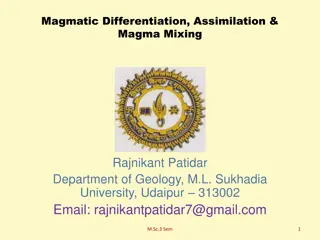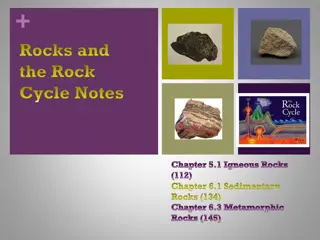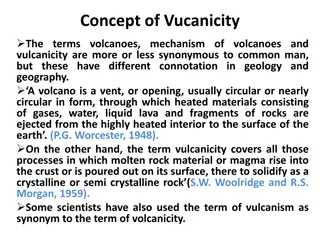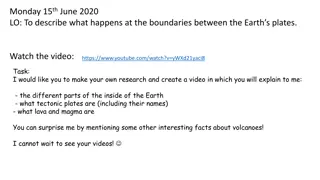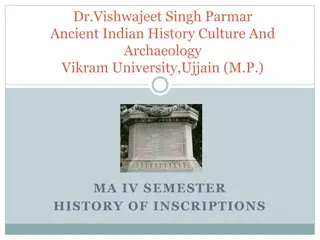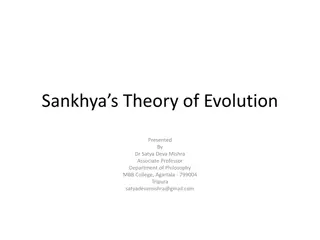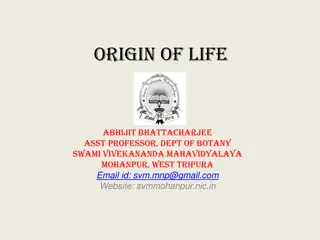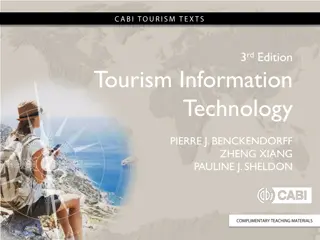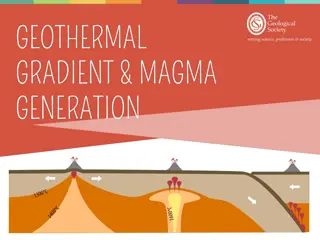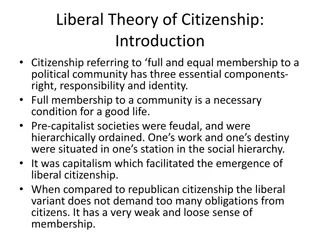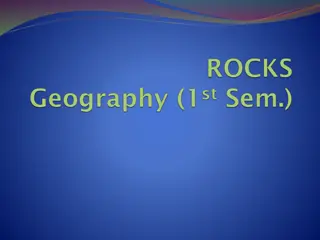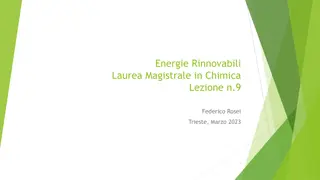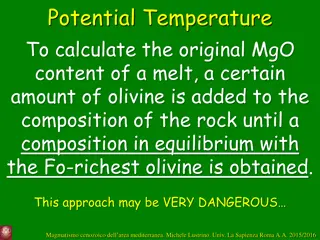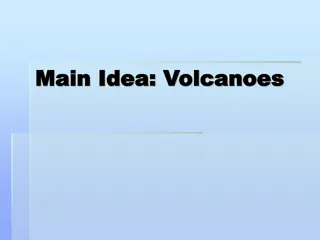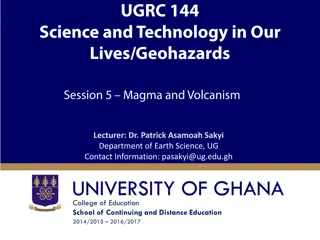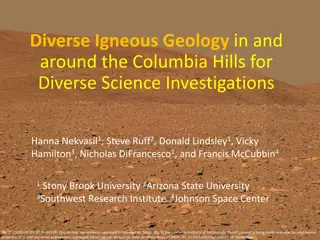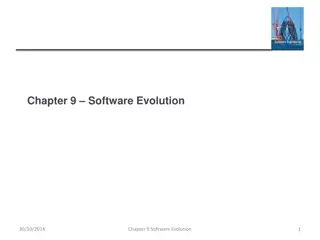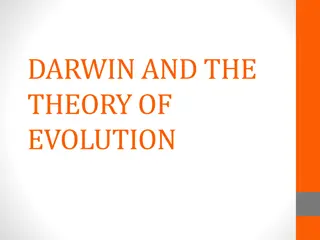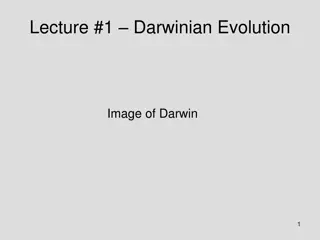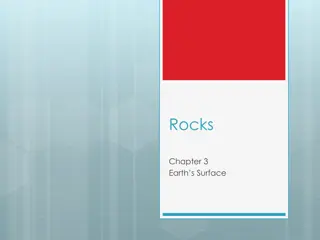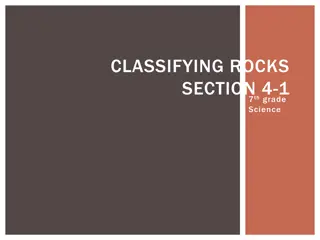Evolution and Plant Systematics Lecture Overview
This lecture outline delves into the concepts of evolution, unity, and diversity of organisms on Earth, covering topics such as fossils, Lamarck and Darwin's theories, adaptation, natural selection, artificial selection, Carolus Linnaeus' systematics, plant evolution, and the demonstration of evolut
5 views • 26 slides
Critique of Unilinear Cultural Evolution Models
The drawbacks of unilinear cultural evolution models are explored, focusing on the assumption that all cultures follow a single linear path of development. Issues such as the emphasis on material culture, overlooking of other cultural aspects, and the ethnocentric perspective towards Western culture
16 views • 17 slides
Understanding Phylogeny and Evolution in Angiosperms
Phylogeny is the study of evolutionary relationships among organisms, depicted in phylogenetic trees based on shared characteristics. This overview delves into terms like homology, analogy, monophyly, and co-evolution in angiosperms with an emphasis on taxonomy, systematics, and the evolutionary his
1 views • 25 slides
Evolution of Modern State: Three Macro-Patterns Explored
The evolution of the modern state is influenced by three key macro-patterns: War and Militarism, Emergence of Capitalism, and Struggle for Citizenship. These patterns involve deep processes of change over long periods, contributing to the development of modern liberal democratic states. War and Mili
0 views • 13 slides
Evolutionary Concepts and Natural Selection Explained
Descent with modification and natural selection play key roles in the process of evolution, as outlined by Darwinian principles. Through examples and historical context, the mechanisms of adaptation and survival of species are elucidated. The concept of variability within populations and the impact
0 views • 15 slides
Understanding Volcanic Eruptions: Key Terminology and Processes
Volcanic eruptions are caused by the release of pressure inside the Earth, leading to the expulsion of magma through volcanic vents. This process results in the formation of cone-shaped mountains or hills known as volcanoes. The magma, which originates from the asthenosphere, rises through cracks in
1 views • 24 slides
Understanding the Geological Time Scale and Earth's Evolution
Studying the geological time scale is crucial for comprehending Earth's history, evolution of life, and significant events that shaped our planet. Evidences like field observations, fossil records, and radioactive dating contribute to constructing this vast timeline. Major occurrences such as mass e
1 views • 46 slides
Understanding Magmatic Differentiation and Magma Mixing
Magmatic differentiation is the process through which a single homogeneous magma can produce diverse rock types by generating fractions of different compositions. This variation in igneous rocks results from mechanisms like fractional crystallization, liquid immiscibility, vapor transport, and diffu
1 views • 29 slides
Understanding the Rock Cycle: Igneous, Sedimentary, and Metamorphic Rocks
This educational material covers the formation and characteristics of Igneous, Sedimentary, and Metamorphic rocks. It includes details on the processes involved, such as heat melting rocks into magma, sediment formation through erosion and deposition, and the differentiation between intrusive and ex
1 views • 16 slides
Understanding Volcanoes: Mechanisms and Vulcanicity
Volcanoes, mechanisms of eruption, and vulcanicity are explored in geology and geography. Learn about volcanic vent characteristics, types of volcanoes, and classifications based on eruption modes. Vulcanicity encompasses processes involving magma ascent and surface appearance.
0 views • 16 slides
Crystallization Principles in Chemical Engineering: Understanding Crystal Formation and Purification Methods
Crystallization is a key process in chemical engineering, involving the formation of solid particles within a homogeneous phase to obtain pure chemical substances. This article discusses the principles of crystallization, the importance of crystal size control, equilibria in the process, and the con
1 views • 40 slides
Exploring the Forces of Nature: Volcanoes and Tectonic Plates
Embark on a journey to uncover the mysteries of the Earth's inner workings by delving into the dynamics of tectonic plates, magma, and lava. Discover the marvels of volcanoes, from their key features to the impact of volcanic eruptions on both the environment and people. Engage in creative tasks lik
0 views • 10 slides
Evolution of Inscriptions in Ancient Indian History
The evolution of inscriptions in ancient India reflects a shift from Prakrit to Sanskrit languages over the centuries, marking changes in content, purpose, and classification. Beginning with Brahmi inscriptions, the transition to Sanskrit gradually replaced Prakrit as the language of choice in North
0 views • 12 slides
Sankhya's Theory of Evolution Explained by Dr. Satya Deva Mishra
Explore the Sankhya philosophy's theory of evolution as presented by Dr. Satya Deva Mishra, covering concepts such as Prakrti, Purusa, theory of causation, evolutes of Prakrti, and the purpose of evolution towards liberation and self-realization.
2 views • 8 slides
Evolution and Impact of Wi-Fi Technology Trends
Discussion on the next generation Wi-Fi technology evolution, target objectives, and requirements aligning with market needs. The presentation covers the evolution of Wi-Fi technology based on requirements from 1997 to 2023, emphasizing the increasing importance of Wi-Fi due to global trends during
1 views • 14 slides
The Mysteries of Life: Origins, Evolution, and Plant Cells
The origins of life on Earth, spanning billions of years, continue to intrigue scientists. From the emergence of the Earth to the evolution of plant and animal life forms, the journey of life is a profound tale of adaptation and survival. Explore the fascinating hypothetical views on the origin of l
2 views • 14 slides
Evolution of Internet Technology in Tourism: A Comprehensive Study
Exploring the impact of the Internet on tourism, this study delves into topics such as historical evolution, Internet usage by travelers and organizations, search engine optimization, and web development for successful tourism sites. Key concepts like ISPs, servers, domains, and eCommerce are discus
0 views • 23 slides
Understanding Earth's Processes: Chapter 6 Clicker Questions
In Chapter 6, the focus is on the melting associated with the addition of carbon dioxide or water to rocks, magma composition, viscosity of hot mafic magma, and identification of pyroclastic flows. Explore these concepts through interactive clicker questions featuring informative images.
0 views • 11 slides
Understanding Earth's Interior Composition and Magma Generation
The Earth's interior comprises the lithosphere, asthenosphere, outer core, and inner core, heated by radioactive decay and residual heat. The lithosphere is rigid, while the asthenosphere beneath can flow plastically. Magma is generated at mid-ocean ridges, hotspots, and subduction zones, where plat
0 views • 8 slides
Evolution of Liberal Citizenship Theory
The liberal theory of citizenship emphasizes the essential components of right, responsibility, and identity within a political community. It contrasts with pre-capitalist societies by offering a weak sense of membership and reduced citizen obligations. The addition of social rights has brought an e
0 views • 15 slides
Understanding Earth's Geology: Chapter 6 Clicker Questions
Chapter 6 of the Earth's geology covers various topics including the melting associated with the addition of carbon dioxide or water to rocks, types of magma based on silica content, descriptions of hot mafic magma, and characteristics of pyroclastic flows in volcanoes. Test your knowledge with thes
0 views • 11 slides
Understanding Rocks and Minerals: Types and Formation
Rocks and minerals are natural substances with distinct characteristics. Rocks are solid aggregates of minerals or mineraloids, while minerals are naturally occurring chemical compounds. There are three main types of rocks: igneous, sedimentary, and metamorphic, each formed through different process
0 views • 16 slides
Unveiling the Power of Geothermal Energy: A Deep Dive into Earth's Renewable Heat Source
Geothermal energy, originating from the Earth's core, offers a sustainable and accessible energy solution. This renewable resource, driven by high temperatures and pressures beneath the Earth's surface, can be harnessed through innovative technologies. Discover how geothermal energy - whether in the
7 views • 15 slides
Evolution of Compact Star-Forming Galaxies and Quiescent Galaxies
The evolution of galaxies from compact star-forming to quiescent states involves processes such as secular evolution, gas inflows, and star formation quenching. By studying the structural relations and star formation in these galaxies, insights are gained into their transition towards quiescence. Th
0 views • 12 slides
Understanding Olivine Equilibrium in Calculating Original Magma Composition
The process involves analyzing olivine in basaltic rocks, selecting olivine with the highest Fo content, calculating the melt composition in equilibrium with this olivine using the distribution coefficient (KD), and determining the potential temperature (Tp) based on the MgO content. The distributio
0 views • 30 slides
The Scopes Monkey Trial: Clash of Cultures and Evolution Debate
Following World War I, the Scopes Monkey Trial in Tennessee marked a pivotal clash between urban and rural cultures over the teaching of evolution. The trial, prosecuted by William Jennings Bryan and defended by Clarence Darrow, resulted in teacher John Scopes being found guilty of violating the ant
0 views • 9 slides
Rules and Practices for Software Evolution Support
This content focuses on the importance of rules and practices to support software evolution, addressing challenges, benefits, and impact on ecosystems. It emphasizes the need for system-specific rules, automatic extraction of conventions, and client support. The evolution of software is highlighted
0 views • 65 slides
Understanding Volcanoes: Structure, Caldera Formation, and Characteristics
Volcanoes are geological formations with vents, craters, and slopes. The structure of a volcano includes a vent for lava emission and a crater connected to a magma chamber. Understanding the difference between a caldera and a crater is crucial - calderas are much larger, around 50 km in diameter, fo
0 views • 5 slides
Understanding Volcanic Processes and Magma Formation with Dr. Patrick Asamoah Sakyi
Explore the dynamics of volcanic eruptions, magma formation, and volcanic materials in this session led by Dr. Patrick Asamoah Sakyi from the Department of Earth Science at UG. Delve into topics such as magma origins, lava composition, factors influencing volcanic eruptions, volcano classification,
0 views • 41 slides
Exploring Diverse Igneous Geology in and around the Columbia Hills
Studying the diverse igneous geology in and around the Columbia Hills provides insights into Martian atmosphere, volatile budget, age, source characteristics, cooling history, and more. Researchers have uncovered valuable information by coupling unaltered igneous rocks with meteorites and surface sp
0 views • 19 slides
Software Evolution: Managing Change and Evolution in Organizational Systems
Software evolution is an essential process for organizations to maintain the value of their critical business assets. It involves adapting to new requirements, addressing errors, and enhancing performance. The majority of software budgets in large companies are dedicated to evolving existing systems
0 views • 61 slides
Darwin and the Theory of Evolution: A Comprehensive Overview
Darwin's Theory of Evolution encompasses the concepts of organisms changing over time and life evolving through natural selection. Influenced by scientists such as James Hutton, Jean Baptiste Lamarck, and Alfred Russel Wallace, Darwin's theory culminates in the idea of evolution by natural selection
0 views • 9 slides
Understanding Evolution: Key Concepts and Perspectives
Explore the concepts of Darwinian evolution, evidence for evolution, Darwin's theory, and the Modern Synthesis. Delve into the spiritual versus intellectual perspectives, the diversity of religious affiliations globally, and the compatibility of faith and science in understanding the natural world a
0 views • 91 slides
The Complicated Formation of Earth's Water: A Detailed Overview
Jun Wu and colleagues at Arizona State University have developed a comprehensive model to explain the origin of Earth's water through stages such as planetary accretion, core formation, and interactions with the solar nebula. By tracing the isotopic composition of hydrogen, they explore how water so
0 views • 7 slides
Unveiling the Cosmic Evolution: A Journey Through Galaxies, Stars, and Empty Space
Delve into the intricate story of the universe's evolution from its hot dense origins to the vast cosmic web of stars and galaxies. Explore questions on stellar birth rates, interstellar medium influences, and the role of dark energy. Follow the journey of three students working on the Cosmic Evolut
0 views • 30 slides
Understanding Evolution: Key Concepts and Perspectives
Explore the key concepts of Darwinian evolution, including evidence for evolution, Darwin's theory, and the Modern Synthesis. Reflect on the relationship between spiritual and intellectual perspectives, emphasizing that different ways of thinking can complement each other. Discover the diversity in
0 views • 91 slides
Visualizing Ontology Evolution for Improved Knowledge Management
Ontologies are dynamic entities that evolve over time, impacting semantically-enabled applications and knowledge acquisition. This work focuses on identifying desired functionalities for ontology evolution systems, highlighting the steps involved in ontology evolution, and emphasizing the importance
0 views • 16 slides
Evolution of Indo-European Languages through Phylogeny Estimation
Explore the evolution of Indo-European languages through phylogeny estimation under a model of linguistic character evolution. Follow the Computational Historical Linguistics Project's collaboration that began in 1994, leading to the development of methods and studies on homoplasy-free evolution and
0 views • 61 slides
Understanding Rocks and the Rock Cycle
Explore the world of rocks through this educational content on Earth's surface, rock cycle, rock types (igneous, sedimentary, metamorphic), and the formation of igneous rocks from magma and lava. Learn how rocks are made of minerals, the continuous process of the rock cycle, and the classification o
0 views • 29 slides
Understanding Rock Classification in 7th Grade Science
When studying rocks, scientists analyze their mineral composition, color, and texture. Rock-forming minerals play a significant role in Earth's geology, with granite and basalt being prime examples. The texture of rocks is determined by the size, shape, and pattern of grains present. Rocks form thro
0 views • 9 slides


